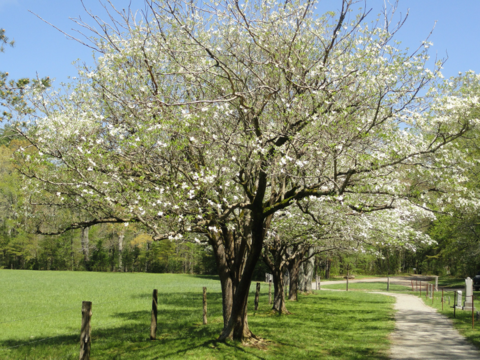Trees create the structure that allows the rest of your landscaping to flourish. Whether small and ornamental or statuesque and stately, here are some great landscaping trees we love.
Eastern Redbud
We all know when spring has officially arrived—it’s when the Redbuds bloom! Their pink flowers are a wonderful sign of the season.
The Eastern Redbud has a stunning spring bloom. But they are also nice ornamental trees through the fall, with pretty, heart-shaped leaves. Fairly small (20-30 feet) they grow quickly at a couple of feet per season. And those gorgeous flowers? They’re edible!
Redbuds are not naturally insect resistant and are susceptible to several different fungal diseases including canker disease and verticillium wilt. There are no treatments but to prune the affected areas. While generally very easy to maintain, you may lose a Redbud to a fungus.

Silver Maple
The big, beautiful Silver Maple may not be an obvious choice for a landscape tree. But it has benefits that other ornamental trees do not—including those spectacular leaves that twinkle with silver when the wind blows.
Silver Maples are ideal for places with poor soil quality. They are easy to grow and grow quickly—more than two feet per year. They have a wide canopy that provides ample shade and a substantial windbreak. Because they are so large (up to 80 feet with large diameter trunks), Silver Maples are hard to incorporate into smaller areas. The shallow but hardy root system can damage home foundations and pavement so they are best in open spaces.
Magnolia
The Magnolia may be the most popular of all the ornamental trees. There are many varieties—we’re going to look at the Saucer Magnolia. We love the Saucer Magnolia because its flowers are gorgeous. It blooms even before the Redbud, a colorful sign that winter is ending. Those flowers arrive before the leaves, which is what makes a Saucer Magnolia in full bloom such a magnificent sight.
The Saucer Magnolia needs sun, but not too much. And it needs to be protected from drought, but too much water makes it vulnerable to fungus. It doesn’t take a lot to keep the Saucer Magnolia happy, but it isn’t a landscape tree to plant and ignore.
Dogwood
Like Magnolias, there are many varieties of Dogwood. Some are large shrubs, others are small trees. We’re going to look at the Flowering Dogwood, a staple ornamental tree. The Flowering Dogwood has lovely pink or white flowers in the spring and pretty red fruit in the fall. Dogwoods look nice and tolerate a variety of growing conditions, making them popular landscape trees.
Be aware when you plant a Dogwood that some varieties have toxic fruit. Check your specific variety to be sure it’s safe for kids or pets in your yard.
Maidenhair
The Maidenhair Tree is a Gingko Biloba, an ancient species that dates back as far as 270 million years. There’s a lot to love about the Maidenhair tree. It’s naturally resistant to disease and bugs, making it a fantastic choice for an eco-friendly yard. It has beautiful fan-shaped leaves that turn bright gold in the fall. It can tolerate some level of pollution and salt, making it ideal for urban planting.
Maidenhairs are either male or female. The female tree’s fruit smells bad and makes a mess when it drops. Try to find a male cultivar. Maidenhair tree fruit is also toxic.
No matter your choices, your landscape trees are functional parts of your outdoor space. Enjoy their beauty and variety!
